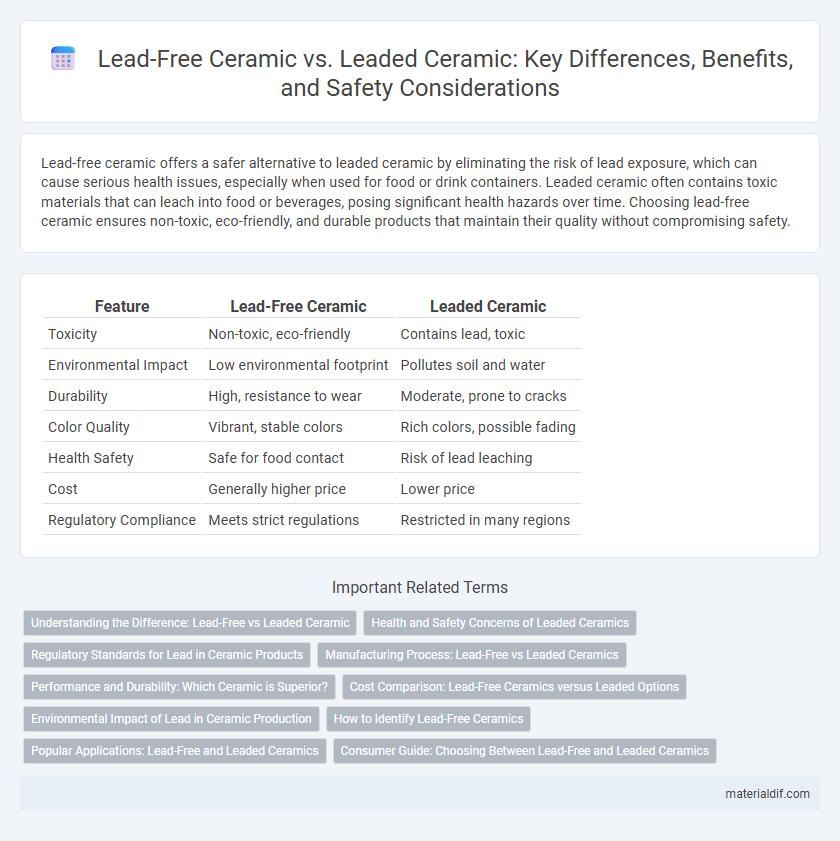Lead-free ceramic offers a safer alternative to leaded ceramic by eliminating the risk of lead exposure, which can cause serious health issues, especially when used for food or drink containers. Leaded ceramic often contains toxic materials that can leach into food or beverages, posing significant health hazards over time. Choosing lead-free ceramic ensures non-toxic, eco-friendly, and durable products that maintain their quality without compromising safety.
Table of Comparison
| Feature | Lead-Free Ceramic | Leaded Ceramic |
|---|---|---|
| Toxicity | Non-toxic, eco-friendly | Contains lead, toxic |
| Environmental Impact | Low environmental footprint | Pollutes soil and water |
| Durability | High, resistance to wear | Moderate, prone to cracks |
| Color Quality | Vibrant, stable colors | Rich colors, possible fading |
| Health Safety | Safe for food contact | Risk of lead leaching |
| Cost | Generally higher price | Lower price |
| Regulatory Compliance | Meets strict regulations | Restricted in many regions |
Understanding the Difference: Lead-Free vs Leaded Ceramic
Lead-free ceramic eliminates the health risks associated with lead exposure, making it safer for food and drinkware applications. Leaded ceramic contains lead oxides to enhance glaze durability and color vibrancy, but poses potential toxic hazards. Regulatory standards increasingly favor lead-free formulations to ensure consumer safety and environmental compliance.
Health and Safety Concerns of Leaded Ceramics
Leaded ceramics release toxic lead particles that pose serious health risks, including lead poisoning, neurological damage, and developmental disorders, especially in children. Lead exposure occurs through food and beverages stored or heated in leaded ceramic containers. Lead-free ceramics eliminate these hazards, offering a safer alternative for everyday use while complying with stringent safety regulations.
Regulatory Standards for Lead in Ceramic Products
Regulatory standards for lead in ceramic products vary globally, with agencies like the U.S. Food and Drug Administration (FDA) setting strict limits on lead content to ensure consumer safety. Lead-free ceramics comply with stringent guidelines such as the California Proposition 65 and European Union's REACH regulation, which restrict lead migration to minimize health risks. Leaded ceramics, often subject to tighter controls, must meet specific migration limits in both food contact and decorative applications to avoid regulatory penalties and protect public health.
Manufacturing Process: Lead-Free vs Leaded Ceramics
Lead-free ceramics utilize alternative raw materials such as bismuth oxide and zinc oxide to replace toxic lead compounds, resulting in a cleaner manufacturing process with reduced environmental impact. Leaded ceramics involve the use of lead oxides which enhance plasticity and lower firing temperatures but introduce health and environmental hazards during kiln firing and waste disposal. Modern lead-free ceramic manufacturing emphasizes strict regulation compliance and energy-efficient sintering techniques to achieve comparable performance without compromising safety.
Performance and Durability: Which Ceramic is Superior?
Lead-free ceramics exhibit superior environmental safety and comparable thermal stability to leaded ceramics, making them ideal for applications requiring non-toxic materials. Leaded ceramics traditionally offer enhanced mechanical strength and durability due to lead oxide additives that improve vitrification and reduce porosity. However, advances in lead-free ceramic formulations have closed the performance gap, delivering high durability and resistance to thermal shock without the health and environmental hazards of lead content.
Cost Comparison: Lead-Free Ceramics versus Leaded Options
Lead-free ceramics generally incur higher manufacturing costs due to the use of more expensive raw materials and stringent processing requirements to ensure compliance with environmental regulations. In contrast, leaded ceramics benefit from lower production expenses, driven by the cost-effectiveness of lead oxide additives and established manufacturing techniques. Despite the initial cost premium, lead-free ceramics offer long-term economic advantages through reduced regulatory risks and enhanced marketability in health-conscious and eco-friendly sectors.
Environmental Impact of Lead in Ceramic Production
Lead-free ceramic production significantly reduces environmental contamination by eliminating toxic lead emissions and hazardous waste associated with leaded ceramic manufacturing. Leaded ceramics contribute to soil and water pollution due to lead leaching, posing serious risks to ecosystems and human health. Transitioning to lead-free ceramics supports sustainable manufacturing and complies with stringent environmental regulations worldwide.
How to Identify Lead-Free Ceramics
Lead-free ceramics are identified by checking for certification labels such as FDA compliance or "lead-free" marks on the packaging. Testing methods include using portable X-ray fluorescence (XRF) analyzers to detect lead content or applying home test kits that indicate lead presence through chemical reactions. Opting for ceramics produced by reputable manufacturers with transparent material sourcing ensures lower risk of lead contamination.
Popular Applications: Lead-Free and Leaded Ceramics
Lead-free ceramics are widely used in food packaging, medical devices, and children's toys due to strict regulatory standards favoring non-toxic materials. Leaded ceramics, containing lead oxide, remain popular in industrial applications such as electronics, glazing, and radiation shielding for their enhanced durability and thermal stability. The shift toward lead-free ceramics is driven by environmental concerns and health regulations, particularly in consumer products and household items.
Consumer Guide: Choosing Between Lead-Free and Leaded Ceramics
Lead-free ceramics ensure consumer safety by eliminating toxic lead content, making them ideal for food and drink containers, especially in households with children. Leaded ceramics often offer vibrant colors and traditional craftsmanship but pose health risks due to potential lead leaching when used with acidic foods or beverages. Choosing lead-free ceramics supports sustainable practices and complies with global regulations, protecting both health and the environment.
Lead-Free Ceramic vs Leaded Ceramic Infographic

 materialdif.com
materialdif.com